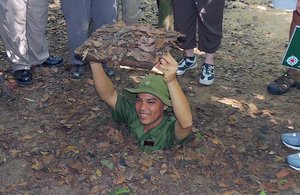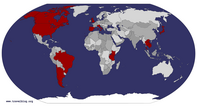Advertisement
Published: June 13th 2017

 Cu Chi Tunnel
Cu Chi Tunnel
Viet Con guerilla war fareGeo: 10.7592, 106.662
DAY TEN (1/12/13) — Saigon
This is such a princess entry but I just have to talk about the accommodations here at the Intercontinental Asiana Saigon. OMG. The beds are simply awesome. And there was a printed invitation last night on our pillow called "Pillow Talk" which invited us to call housekeeping and have our pillows switched out, so Patrick ordered two Latex pillows and he is a very happy camper as well. He said he would be in heaven with this bed at our last resort (on the beach).
There is a dock for my iPhone so it's easy to see my iPhone clock in the night. There is a large flat screen TV. A beautiful view of Saigon at night. And a very sophisticated bath. I love it here in my cocoon.
There are 9.5
million residents in Saigon, who own only a half a million cars but 4 million
motor scooters. Families of four all ride
one scooter as the kids get dropped off at school. It's a wonderment.
A word about the
“horn culture” here – it is incredibly noisy.
Everyone (and I mean everyone) who drives a vehicle honks at everyone
around them. The buses have been deep horns, the vans and shuttles have car
horns and the mopeds and scooters have squeaky horns. They all notify everyone they are coming and
to stay in their own lanes. The big vehicles have right of way and pedestrians
… well, forget it. It is very annoying
and it makes for noise pollution in the big cities like Hanoi and Saigon that
already afflicted with other pollution.
The advice here for dealing with traffic as a pedestrian is to WALK SLOWLY. This allows the drivers of the motorbikes to keep from hitting you – they veer around you, sometimes using the sidewalks and curbs. As a matter of fact, we walked home from the restaurant last night and Cheryl Morley said Saigon doesn't really have sidewalks … simply parking for mopeds. We are amazed and amused.
Following breakfast, we head to Cu Chi Tunnels in Ben Duoc for a close-up look at the Vietnam War. Located in a 120-square-mile area, it is an underground network of living quarters, meeting rooms, triage centers and kitchens, a vast complex that allowed the Viet Cong and North Vietnamese combatants to evade discovery as they moved freely throughout the area, and offers a unique look at life in wartime Vietnam.
Vietnam
Conflict Overview
1954 Dien Bien Phu falls; Vietnam partitioned at 17th parallel1956 Diem proclaims himself president of Republic of SVN 1960 Hanoi forms National Front for Liberation of South1963 Buddhist monk sets himself on fire in protest of religious persecution; Diem killed in coup d'etat1964 Ho Chi Minh Trail becomes supply route from N to S; USNS Maddox attacked in Gulf of Tonkin; US attacks NVN coastal areas1969 US troops peak at 543,000; Ho Chi Minh dies at 79
1970 4 Kent State students protesting war are killed by National Guard; Nixon orders intense bombing1973 Treaty to end war signed in Paris1975 Fall of Saigon; America withdraws last of soldiersStatistics:Civilians killed:665,000ARVN killed:313,000VC killed:251,000US killed:55,000 (1,655 MIA)
Background
When we were in Hanoi, we learned the people there refer to the Vietnam Conflict as the American War. Here in Saigon, they call it the Vietnam War.
After 100 years under French control, the Vietnamese were "liberated" in 1954 by Ho Chi Minh. The French withdrew. The country was partitioned at the 17th parallel, with those in the north under Communism and Ho Chi Minh; and those in the south with Ngo Dinh Diem. Vietnamese could move north or south before the country was officially divided. Catholics mostly went south.
The tunnels were begun in 1945, dug to hide weapons. Later, the tunnels were made longer and dug deeper. From 1961-64, the VC (also known as Viet Cong or National Liberation Front) had the tunnels dug all the way to the Mekong Delta and the Cambodian border. They eventually linked six villages at three levels:
1. First level was the no-smoking kitchen, where there were elaborate ways of keeping smoke from appearing at the surface.
2. Second level was a living area … with school, hospital, even markets, honeymoon room and happy room (rest room), again with an elaborate system to prevent the enemy from finding them as a result of human waste.
3. Third level was 30' underground. First two levels could be damaged by B52 bombers but the 3rd level was safe. It was used for movement to and from Cambodia and for moving weapons from the Ho Chi Minh Trail to where they could be used most effectively.
In 1968 when there was a cease fire for the lunar new year, the VC were able to surprise Saigon and the US Army with its Tet offensive.

 Tunnels are 30" high, lower in many places
Tunnels are 30" high, lower in many places
Unless this, they are dark and very close quartersMost of the element of surprise came from soldiers living in the tunnels near Saigon.
The tunnels were built by villagers in clay, using only hoe and hand. The clay hardened and was difficult to destroy. It's the same clay we walk on today on our tour.
Once the US Army found the tunnels, they tried a variety of ways to neutralize their use: flooding, gassing (but the ventilation system was too good), tunnel rats who went in by foot but who found many many booby traps. And finally bombing with B52s, but even that only destroyed the first and occasionally the second level.
The famous photo of little Vietnamese girl burned by napalm was taken near here
Today's Tour
Our tour today takes us into the jungle where soldiers conducted guerrilla warfare. We walk the same paths soldiers from both sides traversed. The jungle, of course, is nowhere near as dense … or frightening.
We actually go down into the tunnels and see the kitchens, then further down into the hospital and other rooms where the VC lived and worked. The tunnels themselves, in most sections, are about 30" high so there is much stooping to get through. The 6'6" fellow I live with, who also has bad knees, declined.
A word about the tunnels. These are homogenized versions of the real thing. The ones really used by the VC in the 60s had very small entrances (perhaps 12x10” chutes), were completely black inside and very close. They are narrow, low and very hot and steamy. The ones now have wide covered entrances, stairs, lighting. But they demonstrate to us how well they were disguised and they talk about how long it was before the Americans found out about them.
We also learn about the trap system they used. One is life size … maybe 3'x6” and it rotates when stepped on. Victims drop into a pit filled with bamboo spears which impale the soldier and he dies. Very scary.
A word about today:
The venture into the tunnels is worth it. Maybe not the ones at the end where there are a lot of bats, but still … This is definitely a day for all those products they tell you bring along … DEET (I could feel the mosquitoes around me but they didn't light) … WetOnes or other sanitary packets … sunglasses and perhaps a hat
(although truthfully we were in shade most of the time) … walking shoes … and shorts. And perhaps that fan you bought to use at Angkor Wat. Today would have been a good day to try it out had I thought of it.
Lunch is a tasty box lunch at the entrance to the tunnel attraction in a thatched pavilion overlooking the Saigon River. We head back to Saigon and on the way stop at a rubber tree plantation for a brief lesson and demonstration.
We head to the Reunification Palace, formerly the Presidential Palace. We learn about all the people who held the position of president. The position revolved and so did the building. At one time it was an elegant French palace but it was destroyed by bombs. We see elegant state offices and living quarters.
The bus heads back to the hotel, dropping off those who are dying of the heat or exhausted for other reasons. I am among them. My back is killing me. Patrick and David Morley go on to the War Remnant's Museum which has some huge plans, tanks and other war paraphernalia. Inside are famous photos and other propaganda. I'm told it was

 tunnel view from outside
tunnel view from outside
Very small passage into the tunnelsa very one-sided look at the conflict.
After popping Ibuprofen and raising my legs for 30 minutes, I head out shopping with Cheryl Morley. We walk to Le Loi Street and into Saigon Tax. The fourth floor of the department store houses souvenir shops. We buy lacquer goods and other touristy items. On the way back we pass the former City Hall, built by the French; in front is a formal garden, which now has a huge statue of Ho Chi Minh "planted” among the beautiful flowers. The building is now the HQ for Communism here in Saigon. How odd.
We are on our own for dinner, so Larry makes us reservations at Xu, famous for its Vietnamese fusion food. It is quite tasty and well presented. The waitress is quite darling but we can hardly understand a word she says. And she obviously can't understand us. Patrick orders a Coke and it does not taste like a Coke. He sends it back and asks them to make sure it is regular Coke and to leave out the lime. A new one arrives and it tastes the same. He gives up and leaves it on the table. When the

 Cu Chi secret entry -- well disgused
Cu Chi secret entry -- well disgused
Americans didn't discover these for yearsbill arrives, he has been charged for a Grey Goose vodka. Turns out, that's why the Coke is so unusual.
Larry's quote of the day as we head back to Saigon: "You may remove your Cu Chi Tunnel admission stickers if you like. But of course they would be a welcome addition to most any ensemble.”
Advertisement
Tot: 0.355s; Tpl: 0.035s; cc: 6; qc: 45; dbt: 0.0597s; 1; m:domysql w:travelblog (10.17.0.13); sld: 2;
; mem: 1.2mb

















LM
non-member comment
Thank-you for taking your time to post such interesting and valuable information about your adventure. I've enjoyed reading it!!